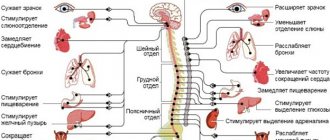Children are our future, and we, adults, are responsible for the health of children, both physical and mental. Sadly, Russia ranks first among suicides and suicidal behavior among children and adolescents in the world. Moreover, every year the number of suicide attempts increases by 1 - 2%.
Timely detection of suicidal behavior and prevention of suicide attempts falls primarily on parents and teachers, although psychologists and psychiatrists play an equally important role in this task.
Statistical data
- About 30% of people aged 14 to 24 have had suicidal thoughts.
- Suicide attempts are made by 6% of adolescent boys and 10% of adolescent girls.
- Only in 10% of cases of suicidal behavior in adolescents they actually want to “commit suicide”, and in 90% of cases it is to attract attention to themselves.
- In children under 13 years of age, suicidal behavior is rare, and from 14 to 15 years of age, an increase in suicidal activity is observed. Its peak occurs in adolescents aged 16–19 years.
- About 34% of minors repeat their suicide attempts, and with each new attempt the likelihood of death increases.
- Up to 80% of suicide attempts occur during the day or evening - as a cry for help and to attract attention.
- About 13% of children and adolescents who died of the total number of violent deaths committed suicide of their own accord.
- Up to 62% of suicides among teenagers were committed due to family conflicts, fear of violence from elders, inappropriate behavior of teachers and conflicts with them, classmates and friends, as well as the indifference of others.
How to watch out for suicidal behavior in a teenager?
Human mental health is one of the basic values of the individual and society as a whole.
It is this indicator that determines the physical and social well-being of a person. Childhood and adolescence are accompanied by radical complex changes in the body and psyche. In the formation of deviations in neuropsychic development, not only previous negative factors are important, such as maternal toxicosis during pregnancy, prematurity, birth injuries, and the effects of toxic substances. Microclimate conditions and relationships in the child’s immediate environment have a significant impact.
Trouble in the family, alcoholism of parents, poor relationships between family members lead not only to mental disorders of the child, but also to antisocial behavior and suicide. Child suicide is inherently terrible and sometimes completely unpredictable.
Some terminology
- Suicide is defined as taking one's own life by one method or another.
- Suicidal thoughts are thoughts about the method of leaving the world, about the reaction of people around, about the painfulness of the very process of taking one’s own life.
- Suicidal plans differ from suicidal thoughts in that a person begins to think through the details of the planned suicide: where, in what way, with the presence of witnesses or leaving a suicide note, etc. This is the first stage before the moment of preparation for suicide.
- Parasuicide is a kind of staging of taking one’s own life, carried out for show, in front of witnesses. Its main meaning is not leaving life as such, but getting what you want: attention, pity, fulfillment of demands.
- Extended suicide is characterized not only by taking one's own life, but also by killing those around him.
- Completed suicide is suicidal behavior that results in death.
Sad statistics
Sadly, Russia is among the world leaders in suicide rates among children and adolescents. The figures are more than 3 times higher than in other countries. In recent decades, peaks in suicidal activity were observed in the 1990s and again in 2002. The average rate among adolescents remains high - about 21 per 100,000 people.
It is worth noting that boys committed suicide more often than girls: 33 and 8 per 100,000 people, respectively. Over the past 5-6 years, suicidal activity has remained at the same level.
The quantitative indicator of suicides differs relative to the regions of the Russian Federation. The largest number of suicides among teenagers is recorded in the Chukotka Autonomous Okrug - 255 per 100,000 population. This figure is lowest in Chechnya - up to 2.3 per 100,000 population. Thus, the southern regions and regions of the country are characterized by lower mortality from suicide than the northern regions (Chukotka, Buryatia, Altai, Yakutia, Tyva, Khakassia, Irkutsk, Kamchatka, Kalmykia).
Despite such high rates of suicide, even these statistics are not able to fully reflect the real picture of suicide. A colossal number of people who commit suicide remain beyond the reporting limits of psychiatric services.
This happens due to various reasons, such as denial by relatives of what happened, problems with insurance companies, etc.
The first "bells"
Recognizing and preventing suicide is not so easy, because not every person planning suicide communicates their intentions to others.
The risk of suicide increases significantly in the presence of depressive disorders in the mental state.
The first obvious signs of a possible suicide in children and adolescents is a depressive state.
Key points to pay attention to:
- low mood;
- loss of appetite;
- apathy;
- sleep disturbance (nightmarish dreams, superficial, anxious and sensitive sleep, insomnia or excessive sleepiness);
- thoughts and statements about unwillingness to live;
- decline in school performance;
- limiting communication with friends and acquaintances;
- tearfulness,;
- refusal to attend classes and classes.
Let's understand the terminology
- Suicide
called the deliberate taking of one's life, which ends in death. In the sense of the psychology of suicide, there is a reaction to affect, the elimination of emotional stress and getting rid of a difficult psychological situation in which a person finds himself. Persons who try to resort to suicide experience severe mental pain and are in a stressful state, do not find a way out of an unfavorable situation other than suicide. - Suicidal behavior is a manifestation of suicidal activity, that is, a person has thoughts and intentions, attempts at blackmail and threats, as well as attempts on his life. The behavior of future suicides, that is, suicidal behavior, is observed both in normal conditions and in psychopathy.
- A suicide is a person who has either attempted suicide or demonstrates readiness for it (suicidal tendencies).
Types of suicidal behavior
There are several types of suicidal behavior (suicidal tendencies):
Demonstrative behavior
With this type of behavior, the teenager has a strong desire to attract attention to himself and his problems, to show how difficult it is for him to cope with life’s problems and difficult situations. This is a kind of cry for help. In the case of demonstrative suicidal behavior, attempts to commit suicide are not made in order to actually achieve a lethal outcome. This is the goal of causing fear among others, an attempt to make them think about his problems and “understand” people about their unfair attitude towards the child. Examples of demonstrating suicidal behavior: shallow and harmless cuts to veins, taking non-toxic drugs, staging self-hanging.
Affective behavior
Affective suicidal behavior is based on strong emotions, under the influence of which a teenager impulsively tries to commit suicide, but does not have a clear plan for suicide. Such emotions are always negative and extremely expressed: resentment, anger. Examples of affective behavior: attempted hanging and poisoning with potent drugs and toxic substances.
True behavior or expressed desire for death
The teenager carefully and thoughtfully prepares for suicide, draws up an action plan in advance, and all attempts are structured so that they actually end in the death of the suicider. As a rule, with this type of suicidal behavior, children leave suicide notes in which they either “forgive everyone everyone” or do not blame anyone for anything, and also explain their desire to end their earthly existence. Examples of true suicidal behavior: hanging and jumping from a height.
Signs of suicidal behavior
Signs of suicidal behavior in teenagers
There is a term “pubertal suicide”, which refers to a whole phenomenon, these are teenage suicides. The peculiarities of manifestations of suicide in childhood and adolescence, the uniqueness of psychology and levels of socialization of children and adolescents, the characteristics of psychopathological conditions, the specifics of prevention - all this gives reason to consider child and adolescent suicidality as an independent field of knowledge.
Suicidal behavior in minors is based on genetic and social reasons. But in adolescence it occurs so often that experts call it a “typical adolescent” behavior disorder. Every teenager has character traits that, by the very fact of their existence, predispose him to suicide. This is emotional instability, often low mood, combined with a decrease in mental and motor activity, unstable self-esteem, difficulties in self-identification, communication problems, egocentrism, in a word, everything that makes a teenager easily vulnerable, very vulnerable and completely unbearable for others.
Domestic researchers (A.G. Ambrumova, E.M. Bruno, N.D. Kibrik, etc.) note the fundamental difference between the suicide of a teenager and the suicide of an adult:
- 1) Firstly, the lack of a real desire and clearly defined motive for committing suicide. Psychotherapeutic practice shows that adolescents cannot clearly identify the reason why they decided to commit suicide (usually, the reason for suicide is perceived by the teenager as a problem that weighs on him, which cannot be resolved). Their explanation of suicidal intent is limited to the phrase “I’m just tired of living.”
- 2) Secondly, the lack of ability to verbalize your feelings, share your experiences, talk about them in detail, and as a consequence of this, the inability to respond to them. Unexpressed negative feelings that have not found a way out accumulate in the already painful soul of a teenager, which only intensifies the child’s depressive state.
Yu.V. Popov assesses one of the forms of suicidal behavior in adolescents - additive. In his opinion, since in most cases suicidal behavior is a kind of “cry for help,” then in a situation of chronic stress, a negative emotional climate in the family, in the absence of positive experience in solving stressful situations, suicidal behavior can be consolidated as a way of at least temporary ( or very quickly) resolution of family and personal problems. And since in children and adolescents the affective reaction, especially if it acquires a pathological character, is characterized by stereotypical repetition, then in the future the teenager gives a habitual reaction to any problems, i.e. becomes dependent on the habitual form of response.
The most common concept in Russian suicidology is the concept of A.G. Ambrumova, according to which the features of suicidal behavior at a young age include:
- 1. Insufficiently adequate assessment of the consequences of auto-aggressive actions. The concept of “death” at this age is usually perceived very abstractly, as something temporary, similar to a dream, not always associated with one’s own personality. Unlike adults, children and adolescents do not have clear boundaries between a true suicide attempt and a demonstrative and blackmailing auto-aggressive act. For practical purposes, this forces all types of auto-aggression in children and adolescents to be considered as types of suicidal behavior.
- 2. The frivolity, fleetingness and insignificance (from the point of view of adults) of the motives that children use to explain suicide attempts. This explains the difficulties in timely recognition of suicidal tendencies and the significant frequency of cases that are unexpected for others.
- 3. The presence of a relationship between suicide attempts in children and adolescents and deviant behavior: running away from home, skipping school, early smoking, petty offenses, conflicts with parents, alcoholism, drug addiction, sexual excesses, etc.
A significant proportion of children and adolescents who attempt suicide experience depression and are in a severe crisis state. A depressive state is typical for minors with a weak type of nervous system, as well as for children with low self-esteem, lack of self-confidence, an unformed emotional-volitional sphere and infantilism. However, teenage depression manifests itself differently than in adults.
There are types of suicidal behavior in adolescents:
- 1) Demonstrative suicidal behavior. It is based on the teenager’s desire to pay attention to himself and his problems, to show how difficult it is for him to cope with life situations. With demonstrative behavior, methods of suicidal behavior most often manifest themselves in the form of cuts to the veins, poisoning with non-toxic drugs, and depictions of hanging. According to A.E. Lichko, only in 10% of cases do teenagers have a true desire to commit suicide, in 90% of cases it is “a teenager’s cry for help.”
- 2) Affective suicidal behavior is suicidal actions committed under the influence of strong emotions. In such cases, the teenager acts impulsively, without a clear plan for his actions. As a rule, strong negative emotions, such as resentment and anger, overshadow the real perception of reality and the teenager, guided by them, commits suicidal actions. With this type of suicidal behavior, they often resort to attempts at hanging, poisoning with toxic and potent drugs.
- 3) True suicidal behavior is characterized by a thoughtful plan of action. A teenager is preparing to commit a suicidal act. With this type of suicidal behavior, teenagers more often leave notes addressed to relatives and friends, in which they say goodbye to everyone and explain the reasons for their actions. Since the actions are deliberate, such suicide attempts often end in death. With this type of behavior, people often resort to hanging or jumping from a height.
It is believed that half of suicide attempts in adolescence are demonstrative, that is, without a real intention to die, but only to put on a performance for others, in order to attract attention, achieve some advantages, and get rid of impending troubles. However, distinguishing between genuine and demonstrative attempts is not always easy. The lack of fear of death underlies the choice of all kinds of dangerous games; the lack of life experience leads to dramatic ways of dying. A teenager, due to his incompetence, may choose potent medications, very similar to vitamins, for demonstrative blackmail behavior. Conversely, sometimes harmless methods of suicide, from the point of view of an adult, indicate a sincere desire to die. Experts suggest that all suicidal attempts by adolescents should be regarded as true and subjected to in-depth analysis.
It is also noted that suicidal behavior in adolescents is mainly a problem of “borderline” psychiatry, i.e. the field of studying psychopathy and non-psychotic reactive states against the background of character accentuation. Only 5% of suicides and attempts are attributed to psychosis, while psychopathy accounts for 20-30%, and the rest is due to so-called teenage crises. According to A.E. Lichko, suicidal behavior is one of the common forms of disorders in psychopathy and non-psychotic reactive states against the background of character accentuations in adolescence. Among the 300 adolescents she examined, demonstrative behavior was found in 20%, affective attempts in 11%, and true, premeditated attempts in only 3%. It should be noted that in adolescents the presuicidal period is not as clearly expressed as at an older age. Therefore, the frequency of completed suicides compared to attempted suicides is relatively low - 1% of suicide attempts among children and adolescents end in death
Thus, a teenager’s suicide is the result of a cry for help not being heard in time.
At 10-12 years of age, death is assessed as temporary. A distinction appears between the concepts of life and death, but the emotional attitude towards death is abstracted from one’s own personality.
Depression manifests itself in different ways, depending on the psychological accentuation of character.
A hyperthymic teenager has a tendency to take risks and neglects danger.
In cyclothymic people there is subdepression, affects, a stamp of despair, an unconscious desire to harm oneself.
In emotionally labile adolescents, affective reactions of the intrapunitive type are significant. Suicidal behavior is characterized by rapid decision-making and is based on a vague desire to “do something with oneself.” Another factor may be the desire to “forget yourself.” Most often, self-destructive behavior is driven by the emotional coldness of loved ones and significant others.
Sensitive teenagers suffer from a feeling of inferiority - reactive depression and the maturation of suicidal intentions with their unexpected realization.
Psychasthenic adolescents in a state of adaptation disorder are characterized by indecision, fear of responsibility, fear of damage to social status.
Children with schizoid accentuation are characterized by the use of doping.
A teenager with epileptoid accentuation, against a background of affect, may go beyond caution. In a state of loneliness or in a hopeless situation, aggression can turn on oneself. Most often, cuts and burns are caused, sometimes for masochistic reasons. Intoxication often occurs in a dysphoric manner with loss of control over oneself. Gamblers. Maximum among drug addicts and substance abusers.
Hysterical teenagers are predisposed to demonstrative suicide.
All the interests of a teenager with unstable accentuation are aimed at obtaining pleasure.
A conforming teenager may commit suicide for company.
If we talk about diagnosing suicidal behavior, then a number of signs may indicate a teenager’s intention to commit suicide:
• Withdrawal. The desire to be alone with oneself is natural and normal for every person. Let's say more, in adolescence this desire is natural. Teenagers begin to think about the meaning of life, build their own world, their own space and limit the access of close relatives to it. For example, a sign “Do not enter, protected area” may appear on the door of a teenager’s room. At the same time, we must remember (tell parents) if isolation and isolation become deep and long-lasting, when a teenager withdraws into himself and avoids close friends, this may be a symptom of self-isolation, an escape from some “unbearable” situation.
• Capriciousness, pickiness. Each of us is capricious and mopey from time to time. This condition in adolescents can be caused by the weather, health, fatigue, information overload, falling in love, school or family troubles, etc. But when you observe that a teenager's mood fluctuates between excitement and depression almost daily, there is cause for concern.
• Depression. This is a deep emotional decline that manifests itself differently in each person. As for teenagers, they become withdrawn, withdraw into themselves, and at the same time they can mask their feelings so well that others may not notice changes in their behavior for a long time. The only way in such cases is direct and open dialogue, clarifying the causes of emotional decline.
• Aggressiveness. Many acts of suicide are preceded by outbursts of irritation, anger, rage, and cruelty towards others. Often such phenomena turn out to be a call from the suicidal person to pay attention to him and help him. However, such a call usually gives the opposite result - the hostility of others, their alienation from the aggressive teenager. Pay attention to children and adolescents who have recently increased their aggressiveness and have had uncharacteristic outbursts of anger and rage.
• Loss of appetite. The absence or, conversely, abnormally increased appetite is closely related to self-destructive thoughts and should always be considered as a criterion of potential danger. An educational psychologist can clarify the presence of such a problem with parents.
• Giving gifts to others. Some people planning suicide first distribute their belongings to loved ones and friends. Teenagers experience a devaluation of what used to be significant. This manifests itself either through the distribution of things (CDs with games, music, favorite clothes, etc.), or through ignoring these values (walks around in only one clothes, the rest hangs in the closet; does not listen to favorite music CDs, does not watch favorite programs, etc.). etc.) As experience shows, this is a direct harbinger of impending misfortune. In each such case, a serious and frank conversation is recommended to clarify the intentions of a potential suicide.
• Psychological trauma. Each person has his own individual emotional threshold. A “breakdown” can be caused by a major emotional shock or a chain of small traumatic experiences that gradually accumulate. Parting with family, home, familiar way of life, encountering significant physical, moral and intellectual stress, an unfamiliar environment and atmosphere may seem to a teenager to be the tragedy of his life. If to this is added the divorce of parents, death or misfortune with someone close to him, personal adversity, he may have thoughts and moods that are fraught with suicide.
• Changes in behavior. Sudden, unexpected changes in a teenager's behavior should be the subject of careful observation. When a reserved, taciturn, withdrawn student, unexpectedly for those around him, begins to joke, laugh, and chat a lot, it is worth taking a closer look at him. Such a change sometimes indicates deeply felt loneliness or psychological trauma, and the teenager strives to hide his experiences under the guise of fun and carefreeness. Another alarming symptom is a decrease in energy level, increased passivity, indifference to communication and life.
• Threat. If a teenager openly expresses his intention to die, this should be taken seriously. These statements can be interpreted as a direct warning of impending suicide. It is necessary to show restraint, calmness, offer him help, not let him leave your office until the degree of risk has been assessed, inform the parents, and, if necessary, consult with medical specialists (by phone).
• Active pre-preparation. It is implemented through active actions: collecting information about toxic substances and medications (other methods of suicide) through analysis of specific literature or the Internet, talking about suicide as an easy death, visiting cemeteries and colorful stories about them, frequent conversations about the afterlife, etc. .
Early identification of adolescents with emotional-behavioral disorders and suicidal risk is facilitated by observation skills. Children and adolescents who find themselves in a crisis situation change. The emotional component, behavior, appearance, relationships with classmates and friends, interests, etc. change.
External and behavioral clues of suicidal risk:
• Sad facial expression.
• Tendency to whine, capriciousness, egocentric focus on one's suffering, tearfulness.
• Hypomimia (increased, often unnatural activity of facial expressions).
• Amymia (lack of facial reactions).
• Quiet monotone voice, slow speech, short answers, no answers.
• Accelerated expressive speech, pathetic intonations, lamentations.
• General motor retardation or inactivity, adynamia (lying on the sofa all the time).
• Motor excitement.
• Tendency to take unreasonably risky actions.
• Boredom, sadness, despondency, depression, gloomy moodiness, anger, irritability, grumpiness.
• Grumping, hostile, hostile attitude towards others, a feeling of hatred for the well-being of others.
• A feeling of physical dissatisfaction, an indifferent attitude towards oneself and others, a feeling of “insensibility”.
• Anxiety is pointless (unmotivated), anxiety is objective (motivated).
• Expectation of irreparable disaster, unmotivated fear, motivated fear.
• Melancholy as a constant background of mood, explosions of melancholy with a feeling of despair, hopelessness, deepening of gloomy mood during joyful events around.
• Assessment of one's own life, pessimistic assessment of one's past, selective recollection of unpleasant events of the past.
• Pessimistic assessment of one's current state, lack of prospects for the future.
• Active interaction with others (desire for contact with others, seeking sympathy) or unsociability, avoidance of contact with others
• Dilated pupils, dry mouth (“dry tongue symptoms”), tachycardia, increased blood pressure, a feeling of tightness of breathing, lack of air, a feeling of a lump in the throat, headaches, insomnia or increased drowsiness, a feeling of physical heaviness, mental pain in the chest, constipation , menstrual irregularities (delay).
Verbal clues (what the child says):
• Direct or indirect messages about suicidal intentions: “I want to die!”, “You won’t see me again!”, “I can’t stand this!”, “This will all end soon!”.
• Jokes, ironic statements about the desire to die, about the meaninglessness of life (“No one has ever left life alive!”).
• Confidence in helplessness and dependence on others (“If something happens to her, I will not survive, but will follow her!”, “If he stops loving me, I will cease to exist!”, etc.).
• Farewells.
• Self-accusation (“I’m a nonentity! I don’t represent anything”, “I’m a brilliant nonentity. If, as one good person says, suicide is natural selection, then why don’t I finally kill myself?”, etc.).
• A message about a specific suicide plan (“I have made a decision. It will happen today, when my parents go to their dacha. I have already found alcohol and pills,” etc.).
What parents can see: first of all, changes in mood, nutrition, changes in sleep, changes in their appearance, self-isolation, interest in the topic of death (the appearance of literature on this topic in the house, correspondence on the Internet, etc.), reluctance to attend clubs , school (including increased absenteeism), serious changes in health (frequent colds, frequent headaches, etc.), etc. What teachers can see: changes in appearance, self-isolation in class and extracurricular activities, deterioration in performance, careless attitude towards their school supplies (even though it was different before), frequent absenteeism (absence from certain lessons), sudden and unreasonable outbursts of aggression, drawings on the topic of death on the last pages of subject notebooks, the topic of loneliness, crisis, loss of meaning in essays on a free topic or in reflections in humanities lessons, etc. What peers can see: self-isolation, sudden mood swings (unusual before), increased aggressiveness, auto-aggression (including verbal cues), changes in appearance, interest in the topic of death (methods of suicide), despondency, changes in interests, etc.
Reasons for suicide
Messages to commit suicide arise without external provocation and, as a rule, manifest themselves in the form of blackmailing loved ones: “Oh, that’s how you are! And that means I’ll do it!” The motives for suicide in adolescents and children are the following:
Lack of mature understanding of death
The teenager does not realize that death is forever. He thinks that if I parrot “them” everything will go back and the problems will disappear. Awareness of death and fear of it are formed only by the age of 18 and later.
There is no recognized ideology in society
In a country where there are no stable concepts about homeland, family, etc., teenagers much more often feel unnecessary and are depressed.
Early onset of sexual activity
It has 2 sides: on the one hand, teenagers feel like adults, and on the other, the early start of intimate life leads to serious disappointments. For example, this could be the loss of a lover (he/she left me), an unwanted and, of course, unexpected pregnancy, sexually transmitted diseases, etc. In this way, the purpose of life is lost and it is impossible to identify ways to achieve it.
Mental conditions
Depression and various psychoses lead to suicide in children in a third of cases. Such teenagers lose their zest for life and cannot experience bright positive emotions and pleasure from what they previously received. The child feels hopeless, hopeless, guilty and self-condemning, and becomes irritable and anxious. Somatic manifestations of anxiety include trembling, rapid breathing and dry lips. The teenager either suffers from insomnia or is drowsy during the day and has unexplained pain in the head or stomach. Psychogenic disorders and mental states are caused by serious losses (loss of health, death of loved ones or a friend, change of place of residence).
Physical state
Children who have serious illnesses: tuberculosis, cancer or heart problems. Moreover, a suicide attempt occurs at the examination stage, when the diagnosis has not yet been established.
Others
- Disharmonious relationships in the family - long-term and ongoing conflicts with parents and brothers/sisters.
- Self-destructive behavior in a teenager - this item includes excessive alcohol consumption, drug addiction, and communication with antisocial company.
- School relations. Teenagers spend most of their time at school, where they may have conflicts with both teachers and classmates.
- Material and everyday difficulties. It is a rare cause of suicide in adolescents.
It is inappropriate to talk specifically about any one motive for suicide. Suicidal behavior is caused by a combination of several dangerous factors that persist for a long time.
Teenagers at risk of suicide
There are so-called “risk groups”, which include adolescents who have one or more factors that significantly increase the likelihood of suicide. A high suicidal risk is noted in the presence of the following circumstances:
- parasuicide, that is, there is a history of an unsuccessful (unfinished) suicide attempt - the probability of a second suicide attempt is 30%;
- auto-aggression - the desire to self-harm;
- suicide among relatives;
- alcoholism and drug addiction (long-term use of alcohol or drugs aggravates depression, aggravates feelings of guilt and worthlessness) - in minors, the probability of suicide is 25 - 30% and in some cases increases to 50;
- suicidal threats (both direct and hidden);
- teenagers are “loners” who do not know how to establish normal interpersonal relationships;
- depressive states, especially prolonged ones;
- hypercriticism towards oneself;
- presence of chronic or fatal diseases;
- suffered humiliation or bereavement (loss of a loved one, friend, relative);
- psychological dissatisfaction (discrepancy between real achievements and perceived successes);
- problems in the family (divorce of parents, etc.);
- a feeling of total loneliness (teenagers rejected by their environment).
What does a teenager want to show?
What goals do suicidal teenagers pursue?
- Protest or revenge. Suicidal behavior of adolescents in the form of “protest” is aimed at causing damage to the offender and taking revenge on him according to the principle: “when I die, it will be worse for you.” In this case, the idea of suicide arises impulsively, and the conflict is acute.
- Summoning The purpose of a suicide attempt is to get help from others to change the situation. In this case, suicidal behavior also develops acutely, and a suicide attempt is often self-poisoning.
- Avoidance of punishment/suffering. The suicide attempt in this case pursues the goal of avoiding punishment when it is threatened, and therefore mental and physical pain.
- Self-punishment. One is forced to resort to a suicide attempt either by feelings of real guilt, or as a consequence of contrived guilt.
- Refusal. A similar type – “refusal” from life – is observed in mentally ill adolescents.
After suicide
In order to reduce the risk of a second suicide attempt, it is recommended to ensure the full support of family, friends and loved ones. Such patients are strictly prohibited from taking alcoholic beverages and drugs. Psychotherapists and relatives of the patient must do everything possible to ensure that the patient has contact with the outside world.
It is recommended to provide the patient with adequate sleep, the duration of which is 7-8 hours. Good results come from attending a self-help and support group. A person’s loved ones should hide all weapons, pills and other items that could cause harm to themselves. Relatives need to seek help from professionals who will develop an effective therapeutic regimen.
Typical signs of impending suicide
In order to promptly recognize a teenager’s desire to commit suicide, adults, especially teachers and parents, must know and be able to identify signs of suicidal behavior in minors.
Emotional disturbances
Various emotional disturbances come to the fore in suicide planning:
- loss of appetite, or, on the contrary, uncontrollable gluttony;
- sleep problems (insomnia or daytime sleepiness for several days);
- constant complaints of causeless somatic ailments (abdominal or headaches, constant fatigue, constipation, dry tongue, etc.);
- indifference to one's own appearance;
- a constant feeling of worthlessness and loneliness, melancholy or guilt;
- being in a state of boredom, gloominess, anger, grumpiness or melancholy;
- refusal of contacts, communication with friends and family, becoming a “loner person”;
- absent-mindedness, which reduces the quality of the work performed;
- thoughts about death;
- uncertainty in the future;
- uncontrollable and sudden attacks of anger;
- motivated or unmotivated fears;
- hatred for the well-being of others.
Behavioral signs
Also in the clinic of suicidal behavior there are characteristic behavioral signs:
- putting your affairs in order (making peace with old enemies, giving away valuable and dear things to the teenager, putting your personal belongings in careful order: in the room, in the closet, on the desk);
- farewell in the form of gratitude to different people for the help and assistance provided in various periods of life;
- external satisfaction in the form of a surge of energy (the decision has been made, the plan has been verified, doubt has disappeared, calm and external relaxation);
- radical change in behavior: skipping school, sloppiness in appearance, failure to complete homework, avoiding communication with classmates, changing from a euphoric state to attacks of despair;
- changes in speech: slowness or speed and expressiveness, brevity of answers or lack thereof;
- written confirmation (diary entries, letters).
Signs of Depression
Suicidal behavior is often accompanied by depression. Depressive conditions are characterized by:
- decreased ability to concentrate and think clearly;
- loss of a sense of satisfaction in situations that evoke positive emotions;
- lethargy and constant fatigue, inhibition of speech and movements;
- lack of efficiency in the educational process and everyday affairs;
- feelings of inferiority and uselessness, loss of self-esteem;
- sleep disorders;
- pessimism about the future;
- inadequate response to praise;
- a feeling of bitter sadness turning into crying;
- appetite disorders, and, as a result, weight gain or loss;
- constant thoughts about death/suicide;
- loss of sexual desire.
Subtle Signs of Depression
Signs of depression vary from person to person. They include insomnia, anxiety, loss of appetite (tendency to overeat), irritability, sadness, anger, and feelings of complete hopelessness. All these manifestations occur among ordinary people, but if they last more than two weeks, this indicates that your friend needs help. Not all people with mental problems think about suicide. An extreme degree of depression pushes one to take a desperate step.
Diagnostics
Close circles (teachers and parents, friends and classmates) believe that diagnosing suicidal behavior is not particularly difficult (I’ll immediately notice that not everything is all right with the child/friend/classmate).
In reality, everything is much more complicated, and “missed” suicides achieve their goal only because they are unheard. Most teenagers planning suicide work with psychologists and teachers, visit doctors and social workers. services for a sufficiently long time in order to speak out and be listened to.
The main “tools” for adults in assessing suicidal risk are:
- conversation with a child;
- constant monitoring of the teenager;
- third-party information received from people close to you;
- psychological tests.
When talking with a child, the following statements prevail, which are important to pay attention to:
- they don't love me;
- I am not needed, I am a useless person;
- I don’t want to see anyone, much less communicate;
- life is meaningless;
- goodbye (this was my last visit);
- I don’t want to live;
- I'm dying;
- I can't stand it.
They consider themselves a burden to loved ones
A person prone to suicide feels like an extra member of the family. He also thinks that he is a completely useless unit for society. He always feels guilty and says phrases like: “If I’m not there, everyone will be better off.” Ironically, pleasant and sweet people are more likely to be depressed. Therefore, be attentive to such statements and do not hesitate to tell your friend the opposite.
Rare shot: Viktoria Isakova showed her grown-up daughter from Yuri Moroz (new photo)
Smooth and fresh skin: dermaplaning, or why a woman needs to shave her face
“We are still friends”: Derevianko commented on the breakup with his wife
Prevention
Prevention of suicidal behavior is a difficult task and includes not only the actions of parents and educators/teachers, but also the peers of a child who is contemplating suicide (friends, classmates, sports teammates, etc.).
It should be remembered that a teenager attempting or planning suicide is, first of all, a cry for help, a request for attention and a desire to be heard. Suicide prevention should include the work of people from close circles on all sides (teachers and school psychologist, family, friends and classmates).
Preventive actions
General preventive measures, first of all, include the creation of favorable socio-economic, socio-pedagogical conditions, promotion of the institution of family, and the full implementation of education for children and adolescents.
Special prevention should be aimed at children at risk, deviant adolescents. It is necessary to protect children from the influence of an antisocial environment, cruelty, violence, and from parental neglect.
Timely seeking medical help can prevent suicide.
In the age of information technology, special attention should be paid to protecting children on the Internet. Virtual groups and clubs are dangerous. Teens come to these pages for a variety of reasons: out of curiosity, to express themselves, to generate self-compassion. But in a number of cases, mutual provocation of each other to active suicidal actions occurs. Mass suicides are the result of such a campaign.
It is necessary to disseminate as much reliable information as possible, to highlight the problem of suicide from the right perspective. It is possible to form true ideas among the population about suicide through thematic lectures and educational events held by specialists in the field of suicidology in schools and colleges.
Recommendations for parents
Parents should know that any suicidal behavior in a child begins with depression. Therefore, preventing child suicide should begin with prevention and taking measures to eliminate decadent mood:
Caring and talking
It is necessary to constantly talk with the child, to be sincerely interested not only in his condition, but also in his plans, unresolved problems and difficulties. In conversations with a teenager, parents should set him up for an “optimistic attitude” and instill confidence in achieving his goals. It is necessary to talk with the child about the future (in a positive way), help resolve difficulties that have arisen, analyze them and look for optimal ways to overcome them. Under no circumstances should parents, when communicating with a teenager, be allowed to reproach him for “constantly looking dissatisfied and grumbling,” or to compare the child with other, more successful, cheerful and positive children. You should also try to reveal to the child the positive sides and hidden resources of his personality. To increase a teenager’s self-esteem, it is allowed to compare his “yesterday” with his “today” and set him up for an even more successful version of the “teenager of tomorrow”.
New cases
The introduction of new things into the child’s everyday life plays a positive role. It is important for parents, together with their teenager, to learn something new and useful every day, to do something they haven’t done before (any hobby, walking together, or reading and discussing books will do). It is worth enrolling your child, as well as the parents themselves, in the gym or doing morning exercises together. It is recommended to reconsider options for performing household chores, carry out general cleaning of the house or even repairs. An alternative is to purchase any pet (perhaps the child dreamed of one in childhood), and caring for a new family member will mobilize the teenager and set him up for a positive perception of life.
Maintaining a daily routine
It is important to establish and monitor compliance with the child’s daily routine. You should pay attention to sufficient and complete sleep, timely and proper nutrition, long walks in the fresh air and active movements (sports games). Improving your physical condition is the first enemy of depression.
The need for consultations with specialists (psychologist, psychotherapist).
To help parents
Providing suicide support is a complex and multi-level process. It should involve not only parents, but also specialists of various profiles: teachers, psychologists, medical and social workers. Only together is it possible to create a happy childhood and future for our children!
Daily regime
Normalization of the biological rhythms of sleep and wakefulness is important in the prevention of affective disorders, in particular depression. It is necessary to competently organize the day of a growing organism - alternate between study and rest, physical activity and relaxation.
The child’s time should be scheduled according to the clock, then there is less likelihood of antisocial and addictive behavior. Limit spending your free time on the computer or playing violent and aggressive computer games. The child does not clearly understand the line between reality and fiction.
Communication with a child
When a child asks for advice, turns to you, persistently demands attention, put aside your important task and listen. Perhaps the child just needs to feel your presence and participation. Approval and voicing your feelings are important keys to your child’s heart and experiences.
No disputes
Reproaches and disputes lead to conflicts in the family. The gap between parents and children widens with every argument. Remember! Misunderstanding between the closest people can become a powerful impetus for a teenager’s suicide.
Learning to listen carefully
- For your child to trust you, become an attentive listener.
- Don’t interrupt, be interested in feelings, ask clarifying questions.
- Offer to solve the problem together, help in word and deed.
- Develop in your child faith in a positive outcome of circumstances.
Block websites and programs that highlight suicide issues. Children and adolescents are the most defenseless category of the population. Be careful and vigilant! Some sites encourage you to join the “game” and carry out assignments. The end result of this quest is an order to kill yourself. Control the flow of negative information coming to your child!
Memo for teachers
An equally important role in preventing suicide in adolescents is played by teachers (the child spends most of his time within the school walls), who must take into account the child’s behavior at school and his interpersonal relationships.
Recommendations for teachers:
- attention and listening to the teenager (the child suffers from loneliness and wants to share painful things);
- correct formulation of questions, calm and intelligible questioning about the essence of an alarming situation, an offer of help;
- lack of judgment and surprise in response to what is heard;
- recognition of the child’s “trouble” as a fact (denying the problem makes the teenager feel worthless and petty);
- destruction of the aura of tragedy about one’s death in a teenager;
- refusing consolation, but convincing the child of the temporary nature of the problem;
- instilling real hope for overcoming difficulties, strengthening his faith in himself and in his own strengths;
- showing understanding and empathy;
- monitoring the student’s behavior, analyzing his relationships with peers.
Recommendations for adults
A number of recommendations have been developed that must be followed in a conversation with a suicidal teenager by any adult in his close circle:
Identifying signs of suicidal behavior
Suicide prevention includes not only the participation of friends and their care, but also timely recognition of signs of impending danger (depression, suicidal threat, previous suicide attempt, behavior change, helplessness and hopelessness, etc.).
Perception of a suicide person as an individual
Accept that the teenager is really planning suicide, so do not allow thoughts about his inability to accomplish his plans (too weak, cowardly, stupid, etc.). Do not believe and do not allow others to convince you that the teenager’s intentions to commit suicide are frivolous. It is better to exaggerate the possible threat of suicide than to underestimate it.
Caring Relationships
In this case, it is not so much words that are important as participation, sympathy and friendly support, which will make the teenager understand that he is needed and loved.
Ability to listen carefully
What is important for a potential suicide is not so much dialogue with an attentive interlocutor, but the opportunity to speak out and be heard in his pain and problem. During a teenager’s monologue, you should try to avoid confusion, condemnation, and shock from what you hear. It is necessary to encourage the interlocutor in revealing his own soul (I appreciate your revelations, I understand that it is very difficult to talk about painful things and the decision to die, I have all my attention). Also important is the ability to “hear with the third ear,” that is, to note behavior and facial expressions, the slightest change in mood and movement, sleep and appetite disturbances.
No disputes
When having a conversation with a suicidal person, it is necessary to abandon all sorts of arguments with him, statements like: “You live much better than others, what do you lack?” or “You will disgrace and make your family unhappy.” Such statements block further frankness of the interlocutor, suppress him even more, and the teenager himself withdraws, as a result of which his conviction to commit suicide only strengthens.
The ability to ask
In a dialogue with a child, asking correctly questions is of no small importance. Don’t be afraid to ask: “Are you contemplating suicide?” - a person who has never thought about this, accordingly, will not come to such a thought. And a teenager with suicidal behavior will feel relieved that someone is interested in his thoughts and experiences and is willing to listen. In his answers, an adult can use paraphrased questions from his interlocutor, which will help him understand his own thoughts and experiences.
Participation, not consolation
The expressed experiences do not imply unjustified consolations from the adult (everyone has had this, you are not the first, you will not be the last), but interest and responsiveness. The conversation should be conducted in the direction of love and care, throwing aside the clichés that are imposed on the language. Otherwise, the teenager will feel even more useless and unnecessary, since for him there were no only true words that would distinguish him as a separate person.
Proposing constructive approaches
Instead of banal phrases: “Think about your family/friends, how they will suffer if you die,” you should ask the child to think about alternative methods, because dying is the last option. It is possible that during the conversation the teenager will rethink his decision and find a way out of the impasse. The optimal solution would be to find out what is still dear to the child and what he values. By guiding him along this path, it is possible to change the decision about his death.
Instilling hope
It is very important to make the child believe in another, less radical solution to a difficult situation such as suicide. Even the slightest glimmer of hope gives a chance to reverse the crisis and abandon thoughts of suicide.
Fighting loneliness
Under no circumstances should you leave a child alone, alone with his feelings and intentions. You can enter into an agreement with a teenager, the essence of which is a promise to contact a specific adult before taking decisive action to discuss alternative methods of behavior.
Help from specialists
Conversations with parents and friends do not help in all cases, no matter how much they want to help a child who has decided to commit suicide. In some cases, the help of a priest, or psychiatrists and psychologists may be effective. In some situations, hospitalization in a psychiatric hospital is required.
Maintaining continued care and support
Even after a critical situation has been resolved, adults should not relax. A deceptive moment can be the active activity of a suicide, asking for forgiveness from people offended by them, repaying debts, fulfilling obligations. Such actions only confirm that the teenager has not given up his intentions. Therefore, it is recommended to show care and support for the child for a long time.
Mood swings
A sign of suicidal tendencies can be frequent mood swings, as well as a sudden and inexplicable loss of interest in certain things. A person can be in a cheerful company and even actively participate in a conversation, but suddenly become despondent as soon as something insignificant reminds him of the bad events in his life. Such changes in mood can develop into depression and make a person feel lonely. A person can also quickly lose interest in his hobby or favorite job and fall into apathy. This behavior often leads to making rash decisions that are dangerous for the person himself.
A teenager who is suicidal
Every person at least once in his life has found himself in a seemingly unbearable and monstrous situation, when the only way out of it is voluntary death. But there is always a way out of any situation, and finding it is the first task for a person who has decided to commit suicide. The following tips will help you overcome seemingly insurmountable difficulties on your own:
- Life will not leave you, there will always be a loophole or a glimmer of hope for solving a problem. The curve will always take you out (as an option - maybe).
- Accept a difficult situation as inevitable, but do not shift the solution to your problems onto the shoulders of others; only you yourself, and not someone else, can survive the crisis.
- Share your thoughts, experiences, difficulties, do not avoid communicating with people.
- Search your memory and remember a person who faced a similar or even more difficult problem, remember how he overcame it and take this person as an example.
- Not all actions and words of others are intended to offend you and cause pain. Calm down and look at the attitude of others towards you from the other side.
- Formulate correct conclusions. A negative result (in this case, defeat) is also a result and gives you invaluable life experience.
- The betrayal of one person does not mean that absolutely all people are “like this,” and a bad mark on an exam is not the end, but only the beginning for a serious struggle (in this case for knowledge).
- You shouldn’t “get hung up” on what happened and chew over the unpleasant situation over and over again. It is impossible to forget it, but throwing it “into the attic of memory” is quite possible.
- Do auto training.
- Try to look great to spite all your enemies and problems.
- Don't be ashamed to ask for help, most people will be happy to provide it.
- If possible, go on a trip, no matter what it is to the nearest village, country house, or just a hike with friends.
- Make yourself happy even in small things, buy something tasty or something you really want.
- Do some sports.
Question answer
Is it true that all suicides are mentally ill people?
Indeed, the incidence of suicide is significantly higher among mentally ill people. But not all suicides suffer from some kind of mental illness; often this is just a cry for help from a suicide.
Is it true that you can’t talk to a potential suicide about death and the possibilities of dying?
No. If a person wants to live, no amount of talk about suicide will prompt the idea of committing it. And, on the contrary, a teenager who is thinking about wanting to commit suicide is happy to discuss this issue with someone and find alternative solutions.
Is suicidal tendencies really hereditary?
This question is difficult to answer, since definitive evidence is not yet available.
If a person talks about suicide, does that mean he will never decide to do it?
No. A person who is planning to die in almost 90% of cases wants and tries to discuss this issue with others. The task of loved ones is to be able to hear the call for help and, if possible, dispel dark thoughts in a potential suicide.
Suicidal thoughts
Suicidal thoughts appear in people during stressful situations and depression. A person has thoughts that he is in a situation from which there is no way out. A person is isolated from the outside world and does not make contact even with family and friends. When suicidal thoughts arise, people engage in risky behavior. They are careless when driving a car or operating a variety of serious machinery.
With suicidal thoughts, a person never has positive emotions. The patient strongly repents and develops pronounced self-criticism. With pathology, the appearance of depression, panic attacks, and mental disorders is observed. With suicidal thoughts, the patient's personality traits change. Such people are constantly excited, they are diagnosed with increased anxiety. With pathology, frequent mood swings are observed. The person is overly preoccupied with the topic of death. He experiences emotional pain that he cannot tolerate.










